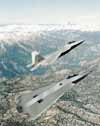FB-22 Fighter Bomber

Air-Attack.com > Military Systems > FB-22 Fighter Bomber
The operational utility of bombers in the new, riskier battlefield of faster, smarter, and longer-ranged defences is one of the top reasons the Air Force is looking at the F-22 and a larger-winged, longer-ranged variant, the FB-22, as midterm strike possibilities, according to Secretary of the Air Force James G. Roche.
"The F-22 ... has about three times the range of any fighter-attack airplane, when loaded with weapons," Roche said. Too often, he said, ranges are quoted for current aircraft that do not include the weight or drag of weapons carried externally. The F-22, with internal carriage of its full weapons load, can attack a target 600 miles away and return on internal fuel, Roche said.
Enhancing this capability by adding range and weapons load resulted in the idea for the FB-22, he said, describing it as a "regional bomber," with a role comparable to that previously covered by the F-111.
The avionics are identical for the F-22 and an FB-22, said Roche, meaning that "one of the most troublesome things" about developing a new aircraft is done. Likewise, engines, the cockpit, and much of the airframe would be similar, and it would still be stealthy, dramatically reducing the cost to fill this new niche. Optimized for ground attack, though, the FB-22 would not be a dogfighter.
"Much bigger wing, more fuel, you can carry more things--but you can't fight," Roche summed up. The payoff would be "instead of carrying eight Small Diameter Bombs on the F-22, you can carry 30 on the FB-22," with a range of 1,600 miles. Such a capability would, in a smaller aircraft, duplicate the fighting effectiveness of two B-2 bombers armed with 2,000-pound JDAM?s. Like the B-2, the FB-22 would carry two pilots, since missions could last more than 12 hours.
In a series or articles by Bill Sweetman for "Jane's Defense Weekly" and Popular Science, the FB-22 s described as a tailless delta variant of the F-22. Yaw control would be provided by split flaps, or "decelerons" on the wings, while roll would be controlled by movable wingtips.
Rather than using the F-22's Pratt & Whitney F119 engines, the FB-22 is likely to have either the new F135, which was developed from the F119 to power the new F-35 Joint Strike Fighter, or the rival General Electric F136. In either event, the FB-22 would have greater speed than the B-1B, the fastest US bomber.
Because of the work already done on the F-22, developing the FB-22 might cost about $5 billion to $7 billion ? a fraction of the price for starting a bomber from scratch. FB-22 flights could begin by 2013. Starting a second final assembly line for the FB-22 at Boeing is under consideration, since Boeing makes the F-22's wings.






